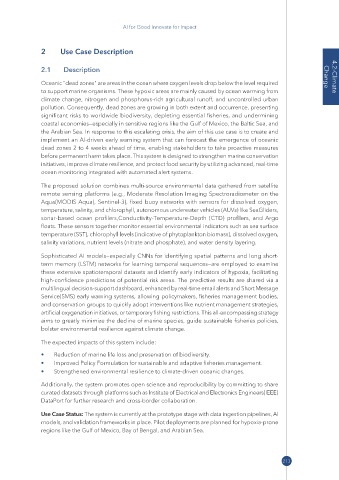Page 249 - AI for Good Innovate for Impact
P. 249
AI for Good Innovate for Impact
2 Use Case Description
2�1 Description
Oceanic "dead zones" are areas in the ocean where oxygen levels drop below the level required Change 4.2-Climate
to support marine organisms. These hypoxic areas are mainly caused by ocean warming from
climate change, nitrogen and phosphorus-rich agricultural runoff, and uncontrolled urban
pollution. Consequently, dead zones are growing in both extent and occurrence, presenting
significant risks to worldwide biodiversity, depleting essential fisheries, and undermining
coastal economies—especially in sensitive regions like the Gulf of Mexico, the Baltic Sea, and
the Arabian Sea. In response to this escalating crisis, the aim of this use case is to create and
implement an AI-driven early warning system that can forecast the emergence of oceanic
dead zones 2 to 4 weeks ahead of time, enabling stakeholders to take proactive measures
before permanent harm takes place. This system is designed to strengthen marine conservation
initiatives, improve climate resilience, and protect food security by utilizing advanced, real-time
ocean monitoring integrated with automated alert systems.
The proposed solution combines multi-source environmental data gathered from satellite
remote sensing platforms (e.g., Moderate Resolution Imaging Spectroradiometer on the
Aqua(MODIS Aqua), Sentinel-3), fixed buoy networks with sensors for dissolved oxygen,
temperature, salinity, and chlorophyll, autonomous underwater vehicles (AUVs) like SeaGliders,
sonar-based ocean profilers,Conductivity-Temperature-Depth (CTD) profilers, and Argo
floats. These sensors together monitor essential environmental indicators such as sea surface
temperature (SST), chlorophyll levels (indicative of phytoplankton biomass), dissolved oxygen,
salinity variations, nutrient levels (nitrate and phosphate), and water density layering.
Sophisticated AI models—especially CNNs for identifying spatial patterns and long short-
term memory (LSTM) networks for learning temporal sequences—are employed to examine
these extensive spatiotemporal datasets and identify early indicators of hypoxia, facilitating
high-confidence predictions of potential risk areas. The predictive results are shared via a
multilingual decision-support dashboard, enhanced by real-time email alerts and Short Message
Service(SMS) early warning systems, allowing policymakers, fisheries management bodies,
and conservation groups to quickly adopt interventions like nutrient management strategies,
artificial oxygenation initiatives, or temporary fishing restrictions. This all-encompassing strategy
aims to greatly minimize the decline of marine species, guide sustainable fisheries policies,
bolster environmental resilience against climate change.
The expected impacts of this system include:
• Reduction of marine life loss and preservation of biodiversity.
• Improved Policy Formulation for sustainable and adaptive fisheries management.
• Strengthened environmental resilience to climate-driven oceanic changes.
Additionally, the system promotes open science and reproducibility by committing to share
curated datasets through platforms such as Institute of Electrical and Electronics Engineers(IEEE)
DataPort for further research and cross-border collaboration.
Use Case Status: The system is currently at the prototype stage with data ingestion pipelines, AI
models, and validation frameworks in place. Pilot deployments are planned for hypoxia-prone
regions like the Gulf of Mexico, Bay of Bengal, and Arabian Sea.
213

